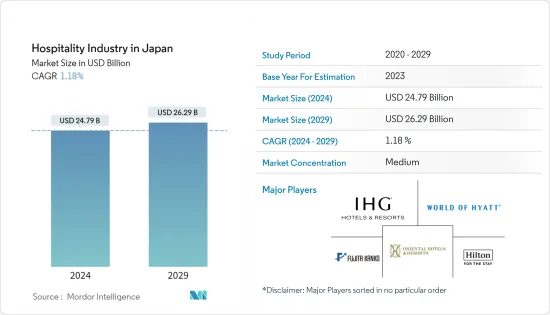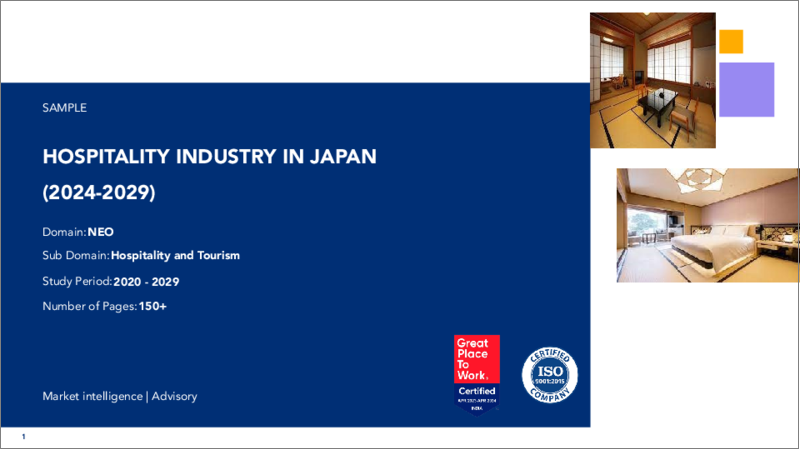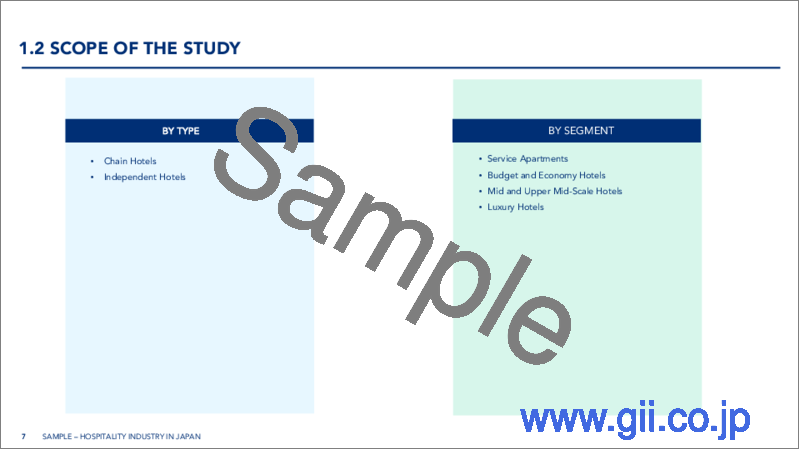|
|
市場調査レポート
商品コード
1435536
日本のホスピタリティ産業:市場シェア分析、産業動向と統計、成長予測(2024年~2029年)Hospitality Industry in Japan - Market Share Analysis, Industry Trends & Statistics, Growth Forecasts (2024 - 2029) |
||||||
カスタマイズ可能
適宜更新あり
|
|||||||
| 日本のホスピタリティ産業:市場シェア分析、産業動向と統計、成長予測(2024年~2029年) |
|
出版日: 2024年02月15日
発行: Mordor Intelligence
ページ情報: 英文 150 Pages
納期: 2~3営業日
|
- 全表示
- 概要
- 目次
日本のホスピタリティ産業の市場規模は、2024年に247億9,000万米ドルと推定され、2029年までに262億9,000万米ドルに達すると予測されており、予測期間(2024年から2029年)中に1.18%のCAGRで成長します。

日本では、ホテルの業績は2021年の大半を通じて低迷が続いた。しかし、「Go To」トラベルキャンペーンの助けがなくても、稼働率は前半期からわずかに回復し、2020年下半期の水準にほぼ達しています。また、ホテル収益も若干改善しております。 2021年下半期には、平均日割り料金(ADR)指数が前年同期比(HoH)0.8ポイント上昇し、それに応じて利用可能部屋当たりの収益(RevPAR)指数も3.8ポイント HoH上昇しました。
新型コロナウイルス感染症(COVID-19)のパンデミックにより、宿泊施設や企業イベントや宴会などの主要な収益源からの収益が大幅に減少しており、日本のホスピタリティ業界は過去2年間苦戦を強いられています。2020年は倒産件数が急増し120件を超え、その半数以上がパンデミックによるものだった。 2021年の倒産件数は減少したが、その3分の2以上がパンデミックによるもので、影響が長引くことを示しています。
特に低予算ホテルは、市場での供給量が多いため、パンデミックによってより大きな打撃を受けています。このようなホテルの客室サイズの小ささは、特にパンデミック後、顧客と運営者の両方にとって問題となっているようです。
海外の投資家も日本のホスピタリティ産業に注目しています。例えば、ベアリング・プライベート・エクイティ・アジアは、大阪市中央区の大型ホテル、ザ・ビー大阪御堂筋を推定100億円(7,400万米ドル)以上の取引で買収しました。全体として、2021年はホテル部門で大規模な取引が見られましたが、パンデミックを考慮すると取引量は比較的少なくなっています。
日本のホスピタリティ市場動向
観光客の増加が市場を牽引
外国人旅行者が徐々に日本に戻ってきています。日本政府観光局によると、9月に日本を訪れた海外観光客は20万6500人となった。COVID-19感染症のパンデミックが始まって以来、この数字が20万人を超えたのは初めてです。訪問者数は韓国が3万2700人で最も多く、次いでベトナム3万900人、米国1万8000人、中国1万7600人となった。
政府は3月以降、国境管理措置を段階的に緩和しており、その後、日本の国境がほぼ完全に閉鎖されていた2021年と比べて海外からの訪問者数が大幅に増加しました。 9月は前年同月と比べて11倍以上の増加となった。
国境制限の緩和は急速な円安と同時に行われ、多くの外国人観光客にとって日本はより手頃な選択肢となった。海外からの観光客の数は今後数カ月間も増加し続けると予想されます。
高級ホテルセグメントの台頭が日本市場を後押し
高級ホテル部門は、市場での展開を拡大しようとしている多くのブランドの注目を集めています。
日本には他国に比べて高級ホテルの数が比較的限られています。ファイブスターアライアンスによると、日本には50を少し超えるホテルが掲載されています。対照的に、多くの西側諸国はこの数を完全に小さくしており、香港やシンガポールなどのアジア太平洋地域の近隣諸国でさえ、経済規模が大きく異なるにもかかわらず、同等の数の高級ホテルを持っています。
多くの有名な国際ブランドがすでに日本に高級ホテルをオープンし始めています。例えば、2020年末にはザ・トーキョー・エディション虎ノ門がオープンし、マリオットは2022年にザ・トーキョー・エディション・銀座とその拠点を拡大し続ける予定です。ホテル部門への投資額は前年並みであり、今後も期待されています。日本のホテル市場には、さらに近いうちにチャンスが生まれる可能性があります。
日本のホスピタリティ産業の概要
日本のホスピタリティ業界は、国内のホテル会社が大半を占めています。国内ブランドとそのチェーンが市場シェアの約90%を占めています。東横インは客室数・鍵の供給数において国内最大のホテルチェーンです。全国に250を超えるホテル施設があり、約50,000の部屋/キーを提供しています。しかし、技術の進歩とサービスの革新に伴い、他の国内外の企業も新たな契約を獲得し、新たな市場を開拓することで市場での存在感を高めています。東横イン、ルートインホテルズ、アパホテル&リゾート、プリンスホテル&リゾーツ、スーパーホテルなどの企業がレポートで紹介されています。
その他の特典
- エクセル形式の市場予測(ME)シート
- 3か月のアナリストサポート
目次
第1章 イントロダクション
- 調査の成果
- 調査範囲
第2章 調査手法
第3章 エグゼクティブサマリー
第4章 市場考察と力学
- 市場概要
- 市場力学
- 促進要因
- 抑制要因
- 機会
- ポーターのファイブフォース分析
- 宿泊施設と飲食品部門の収益フローに関する洞察
- 日本の主要都市の観光客数
- ホスピタリティー産業への投資(不動産、FDI、その他)
- ホスピタリティ産業における技術革新
- 共同生活空間がホスピタリティ産業に与える影響についての洞察
- ホスピタリティ産業へのその他の経済貢献に関する洞察
- COVID-19のホスピタリティ産業への影響
第5章 市場セグメンテーション
- タイプ別
- チェーンホテル
- 独立系ホテル
- セグメント別
- サービスアパートメント
- バジェット・エコノミーホテル
- 中上級ホテル
- 高級ホテル
第6章 競争情報
- 市場集中度の概要
- 企業プロファイル
- Toyoko Inn Co. Ltd
- Route-Inn Hotels
- APA Hotels & Resorts
- Prince Hotels & Resorts
- Super Hotel Co. Ltd
- Okura Nikko Hotels
- Marriott International
- Tokyu Hotels
- JR Hotel Group
- Hotel Mystays
第7章 業界の将来
第8章 付録
The Hospitality Industry in Japan Market size is estimated at USD 24.79 billion in 2024, and is expected to reach USD 26.29 billion by 2029, growing at a CAGR of 1.18% during the forecast period (2024-2029).

In Japan, hotel performance remained weak for most of 2021. However, slightly recovering occupancy rates from the previous half-year are almost at the levels seen in 2H/2020, even without the help of the 'Go To' Travel campaign. Moreover, hotel revenues have also improved slightly. In 2H/2021, the average daily rates (ADR) index increased by 0.8 points half-year-on-half-year (HoH), and the revenue per available room (RevPAR) index increased accordingly by 3.8 points HoH.
With the COVID-19 pandemic drastically decreasing revenue from accommodation and other key revenue streams, such as corporate events and banqueting, the hospitality industry in Japan has been struggling over the past two years. 2020 saw a rapid increase in the number of bankruptcies, exceeding 120 cases, more than half of which resulted from the pandemic. While the number of bankruptcies in 2021 has fallen, more than two-thirds were due to the pandemic, showing its lingering effects.
Budget hotels, in particular, have been hit harder by the pandemic due to the large supply in the market. The small room sizes of such hotels appear to be an issue for both customers and operators, especially after the pandemic.
Overseas investors have also been looking at the Japanese hospitality industry. For instance, Baring Private Equity Asia acquired The B Osaka Midosuji, a large hotel in Chuo ward, Osaka, in a transaction estimated at over JPY 10 billion (USD 74 million). Overall, while 2021 has seen large transactions in the hotel sector, transaction volumes have been relatively low considering the pandemic.
Japan Hospitality Market Trends
Increasing Number of Tourists is Driving the Market
International travelers are slowly returning to Japan. According to the Japan National Tourism Organization, the country welcomed 206,500 overseas visitors in September. It was the first time the figure has surpassed 200,000 since the start of the COVID-19 pandemic. The largest number of visitors was from South Korea at 32,700, followed by Vietnam at 30,900, the United States at 18,000, and China at 17,600.
The government has gradually eased border control measures since March, and the number of overseas visitors has subsequently increased significantly compared to 2021, when Japan's borders were almost completely closed. September saw a more than 11-fold increase compared to the same month a year earlier.
The easing of border restrictions coincided with the rapid depreciation of the yen, which has made Japan a more affordable option for many foreign tourists. The number of overseas visitors is expected to continue to climb in the months ahead.
Rising Luxury Hotel Segment Boosting the Market in Japan
The luxury hotel sector has garnered the attention of many brands looking to expand their footprint in the market.
Japan has a relatively limited number of luxury hotels compared to other countries. According to Five Star Alliance, Japan has slightly over 50 hotels listed. In contrast, many Western countries completely dwarf this number, and even neighbors in the Asia Pacific, like Hong Kong and Singapore, have a comparable number of luxury hotels despite the vast difference in the sizes of their economies.
Many well-known international brands have already started opening luxury hotels in Japan. For instance, in late 2020, The Tokyo EDITION, Toranomon, was opened, and the Marriott will keep expanding its footprint with The Tokyo EDITION, Ginza, in 2022. Investment volumes in the hotel sector were on par with the previous year and are expected to increase in 2023. Opportunities in the Japanese hotel market are likely to emerge shortly further.
Japan Hospitality Industry Overview
Homegrown hotel companies largely dominate the hospitality industry in Japan. Domestic brands and their chains constitute around 90% of the total market share. Toyoko Inn Co. is the largest hotel chain in the country in terms of rooms/key supply. It has more than 250 hotel properties and offers around 50,000 rooms/keys across the country. However, with technological advancement and service innovation, other domestic and international companies are increasing their market presence by securing new contracts and tapping new markets. Players including, Toyoko Inn Co Ltd., Route-Inn Hotels, APA Hotels & Resorts, Prince Hotels & Resorts, and Super Hotel Co Ltd., among others have been profiled in the report.
Additional Benefits:
- The market estimate (ME) sheet in Excel format
- 3 months of analyst support
TABLE OF CONTENTS
1 INTRODUCTION
- 1.1 Study Deliverables
- 1.2 Scope of the Study
2 RESEARCH METHODOLOGY
3 EXECUTIVE SUMMARY
4 MARKET INSIGHTS AND DYNAMICS
- 4.1 Market Overview
- 4.2 Market Dynamics
- 4.2.1 Drivers
- 4.2.2 Restraints
- 4.2.3 Opportunities
- 4.3 Porter's Five Forces Analysis
- 4.4 Insights into Revenue Flows from Accommodation and Food and Beverage Sectors
- 4.5 Leading Cities in Japan with Respect to Number of Visitors
- 4.6 Investments (Real Estate, FDI, and Others) in the Hospitality Industry
- 4.7 Technological Innovations in the Hospitality Industry
- 4.8 Insights into Impact of Shared Living Spaces on the Hospitality Industry
- 4.9 Insights into Other Economic Contributors to the Hospitality Industry
- 4.10 Impact of COVID-19 on the Hospitality Industry
5 MARKET SEGMENTATION
- 5.1 By Type
- 5.1.1 Chain Hotels
- 5.1.2 Independent Hotels
- 5.2 By Segment
- 5.2.1 Service Apartments
- 5.2.2 Budget and Economy Hotels
- 5.2.3 Mid and Upper Mid-scale Hotels
- 5.2.4 Luxury Hotels
6 COMPETITIVE INTELLIGENCE
- 6.1 Market Concentration Overview
- 6.2 Company Profiles
- 6.2.1 Toyoko Inn Co. Ltd
- 6.2.2 Route-Inn Hotels
- 6.2.3 APA Hotels & Resorts
- 6.2.4 Prince Hotels & Resorts
- 6.2.5 Super Hotel Co. Ltd
- 6.2.6 Okura Nikko Hotels
- 6.2.7 Marriott International
- 6.2.8 Tokyu Hotels
- 6.2.9 JR Hotel Group
- 6.2.10 Hotel Mystays*






